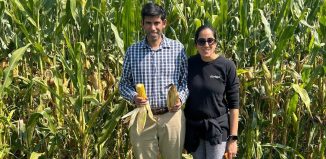CSH’s Tony Zador: studying the brain’s wiring
Testing a bar-coding approach as a cost-effective way to study how neurons interact
Using the three pounds of matter between his ears, Tony Zador came up with an idea. Instead of looking closely at all the individual neurons to understand the connections in the brain, he would take advantage of a cost-effective way to monitor those links.
A professor of biology and program chair of neuroscience at Cold Spring Harbor, Zador has created a bar-coding system in which he hopes to label each neuron. He also plans to monitor the connections among those neurons.
Scientists “know a lot about individual neurons, but far less about how they’re wired up,” Zador said. “Much of the scientific community believes that disorders like autism and schizophrenia arise from problems with wiring. My core interest is in understanding how we go from a wired-up brain to behavior.”
The way our brains work has become a new frontier in science, as President Obama announced a new brain initiative. The effort is designed to enhance our understanding of the mind, help combat diseases and disorders, and lead to new companies and jobs.
Zador’s bar-coding approach differs from that of many other researchers.
“Very smart people at great places — MIT, Harvard, Stanford — are all trying to develop the technology to put together a wiring diagram using electron microscope images. The problem is, even if they succeed, it’s incredibly expensive,” Zador said.
The cost of sequencing genes has gone down precipitously over the last decade. About 10 years ago, the cost for determining the order of base pairs for a person was about $1 billion. Today, that is now about $1,000 to $3,000, Zador estimated.
“If we could somehow convert the problem of figuring out the connectivity of the brain to a problem of sequencing DNA, then this problem, in principal, would be quick and cheap,” he said.
The way this works is by studying mice in which each neuron has a unique DNA label (created by his lab). He believes those labels will not affect the circuitry of the brain, although he plans to test that hypothesis. By looking at these circuits, he will be able to get an idea of how they connect.
The science is a “work in progress,” he said. He’s about to submit a proof of principle that shows how the process works.
If and when this system works and the researchers can determine the typical connections in the brain, they might start looking at the brains in a mouse model of autism.
“It’s quite plausible to believe we’ll get a much better understanding of what’s going on in the brain of someone with autism or schizophrenia if we can understand what happens in a mouse that has those genes disrupted in the way they are in humans,” he said.
Knowing what the normal circuit looks like is a starting point that opens up a wide range of questions.
At this point, one of the theories about autism is that some of the longer-range neuronal connections are impaired, while the local connections are more active.
If that turns out to be the case, scientists might be able to use different drugs to enhance one type of connection while quieting the effect of another.
While Zador came up with an idea he believes will work, his background in physiology and computational and theoretical science didn’t prepare him to develop the molecular biology techniques he’d need for his research. An avid runner who covers five or six miles each day — either outside the lab or on a treadmill — Zador used to run alone.
For the last five or six years, he’s run a few times a week with Josh Dubnau. A colleague at CSHL, Dubnau provides a “one hour tutorial” on molecular biology with each run — while discussing other scientific challenges and, on occasion, politics.
A resident of Laurel Hollow, which is within walking distance of the lab, Zador and his wife Kathy Shamoun, who practices Chinese medicine at Cold Spring Harbor and is also a childbirth educator, have two sons, 7-year-old Ronin and 3-year-old Bowie.
Zador recognizes his research is going in a different direction from other scientists.
“What are the chances it’s going to work?” he wonders. “I’m betting my career on it. I’m enthusiastic and optimistic.”
Correction:
In the article “BNL’s James Dickerson: facilitating nanotechnology” that ran last week, we incorrectly reported how long the Center for Functional Nanomaterials has been open. The building has been open for 5 years. We regret the error.






